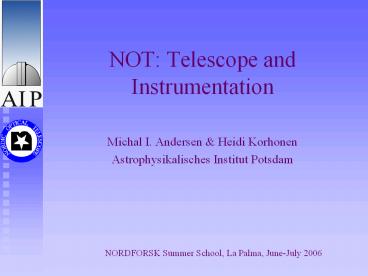NOT:%20Telescope%20and%20Instrumentation - PowerPoint PPT Presentation
Title:
NOT:%20Telescope%20and%20Instrumentation
Description:
Astronomical imaging. What we in general want is. Largest possible field of ... Mounted in the Cassegrain focus, together with the filter & shutter unit (FASU) ... – PowerPoint PPT presentation
Number of Views:55
Avg rating:3.0/5.0
Title: NOT:%20Telescope%20and%20Instrumentation
1
NOT Telescope and Instrumentation
- Michal I. Andersen Heidi Korhonen
- Astrophysikalisches Institut Potsdam
2
Outline
- A brief introduction to optics
- Image formation and the diffraction image
- Seeing
- The telescope
- Instrumentation
- Imaging (Stancam, MOSCA, ALFOSC, NOTCam)
- Spectroscopy (ALFOSC, NOTCam, FIES, SOFIN)
- Polarimetry (ALFOSC, SOFIN)
3
A brief introduction to optics
- The perfect imaging system transforms a
diverging spherical wave into a converging
spherical wave
4
The diffraction image
- Resolving power a 1.22 ?/D
5
The diffraction limit
- An image which has gt 80 of the theoretical
central intensity is said to be diffraction
limited. - The corresponding wavefront error across the
entrance aperture is lt ?/18 RMS.
6
Seeing
- Thermal turbulence in the atmosphere leads
to a distorted wavefront
7
The Fried parameter
- The Fried parameter, ro, is the diameter of
the area across which the wavefront is
diffraction limited. - The relation between ro and wavelength
- ro ?1.2
- The relation between ro and seeing at 500nm
- f 0.104 / ro
8
The seeing Point Spread Function
- The time averaged seeing PSF is smooth and has
broad wings
9
Modern optical telescopes
- Compact optical system reduces overall cost ?
Cassegrain type designs dominate - High stability (lt50nm) of the optical surface
required ? use low expansion mirror substrates
(Zerodur, a 10E-7) - High stability of mechanical support system ? use
Alt-Az mount and active optics
10
General optical parameters
- Diameter (mine is bigger than yours......)
- Focal length / plate scale
- Focal ratio (often also refered to as speed)
11
The NOT
- Effective diameter 2495 mm
- F/2 main mirror focal ratio (this is fast)
- F/11 Cassegrain focal ratio
- ? 27500 mm focal length
- ? 133 micron/arcsec plate scale
- Central obscuration 600 mm
- Unvignetted field of view 30
12
ZEMAX demo the telescope
13
NOT thermal design
- Side ports ensures flushing of air through the
dome a radical approach for its time - Observing floor insulated from control room by a
cooling jacket - Airconditioning of dome during day time and of
floor cooling jacket during night - Lightweight telescope design (finite element
analysis) and thin mirror ensures faster thermal
equilibrium
14
Telescope Control System
- Centralized control computer (earlier 4 CPUs, now
only one). - Limited need for cummunication betweem
sub-systems - This approach has resulted in a very stable TCS
15
Astronomical imaging
- What we in general want is
- Largest possible field of view (FOV)
- Sharpest possible images
- Good sampling (3 pixels per FWHM)
- Stable and field independent Point Spread
Function - High sensitivity (and large telescope)
16
Field size vs sampling Direct imaging vs focal
reducer
- For a given detector (pixel size and format),
the field size and sampling are complementary - You can place the detector directly in the
focal plane and get good sampling (typically
0.1/pix for the NOT), but a small field - Or you can use a focal reducer to better
match the sampling to the seeing, get larger
field, but also lower efficiency, PSF variations
and distortion.
17
Direct imaging at the NOT IStanCam
- Permanently mounted on the side of the
adaptor. Always on standby. Light is directed to
StanCam by inserting a 45deg mirror in the beam - Detector Site 1k x 1k, 24 micron pixels
- Field of View 3.4 arcmin square
- Sampling 0.19/pixel
- Filter size 60mm round, 51mm sqr.
18
Direct imaging at the NOT IIMOSCA
- Mosaic CCD camera for wider field high-
resolution imaging. Mounted in the Cassegrain
focus, together with the filter shutter unit
(FASU) - Detectors Four 2k x 2k 15µ pixel Loral CCDs
- Field of view 7.7 x 7.7 arcmin square
- Sampling 0.11/pixel
- Filter diameter 100mm
19
ALFOSCfocal reducer and spectrograph
- By turning the wheels of ALFOSC one can do
- Imaging through narrow and broadband filters
- Longslit spectroscopy with 14 different grisms
- Echelle spectroscopy
- Multi Object Spectroscopy
- Polarimetry
- Spectropolarimetry
- ? Gives the observer a lot of choice and is
- therefore popular (used 70 of the time)
20
ZEMAX demo of ALFOSC
21
ALFOSC parameters
- ALFOSC is mounted in the Cassegrain focus
together with the filter and shutter unit (FASU) - Detector 2k x 2k 13.5µ pixel E2V CCD
- Field of view 6.5 x 6.5 arcmin square
- Sampling 0.19/pixel
- Filter size 60mm round, 51mm sqr, 90mm round
22
NOTCam the cool sister of ALFOSC
- NOTCam is an infrared (IR) instrument for
the 0.8-2.5µ wavelength range. Because IR
instruments must be cooled to minimize thermal
radiation, it cannot easily be serviced. Also,
the detector is very expensive. - It is therefore an advantage to build as much
functionality into an IR instrument as reasonably
possible. - The NOTCam optical design therefore looks
much like that of ALFOSC.
23
ZEMAX demo of NOTCam
24
NOTCam parameters
- NOTCam is mounted in the Cassegrain focus
- Detector 1k x 1k 18.5µ pixel Rockwell HgCdTe
- Low resolution mode
- Field of view 4.0 x 4.0 arcmin square
- Sampling 0.23/pixel
- High resolution mode
- Field of view 82 x 82 arcsec square
- Sampling 0.08/pixel































